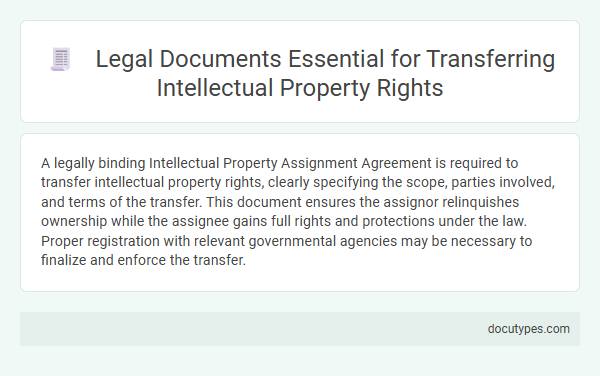A legally binding Intellectual Property Assignment Agreement is required to transfer intellectual property rights, clearly specifying the scope, parties involved, and terms of the transfer. This document ensures the assignor relinquishes ownership while the assignee gains full rights and protections under the law. Proper registration with relevant governmental agencies may be necessary to finalize and enforce the transfer.
Introduction to Intellectual Property Rights Transfer
Transferring intellectual property rights involves legally assigning ownership of creations such as patents, copyrights, or trademarks from one party to another. This process requires specific documentation to ensure clear and enforceable rights transfer.
The primary legal document used for this purpose is an Intellectual Property Assignment Agreement. This agreement outlines the details of the transfer, including the rights conveyed, parties involved, and any compensation terms. Proper execution of this document is essential to establish valid ownership and avoid future disputes.
Importance of Legal Documentation in IP Transfers
Transferring intellectual property rights requires precise legal documentation to ensure ownership is clearly and legally conveyed. Proper documents protect both parties and prevent future disputes over the intellectual property.
- Assignment Agreement - This legal contract formally transfers ownership of intellectual property from one party to another.
- License Agreement - Specifies the terms under which intellectual property rights are permitted to be used without transferring ownership.
- Written Consent or Release - Provides documented approval necessary for the transfer, especially when multiple stakeholders are involved.
Assignment Agreements: Key Components
Transferring intellectual property rights requires a carefully drafted legal document to ensure clear ownership transfer. Assignment agreements are the most common and effective instruments used for this purpose.
- Identification of Parties - Clearly specifies the assignor and assignee involved in the transfer.
- Description of Intellectual Property - Details the specific intellectual property rights being assigned, including patents, copyrights, or trademarks.
- Terms of Assignment - Defines the scope, duration, and any conditions related to the transfer of rights.
Properly executed assignment agreements protect both parties and ensure the lawful transfer of intellectual property rights.
Licensing Agreements: Scope and Structure
What legal document is essential for transferring intellectual property rights through licensing agreements?
Licensing agreements define the scope and structure of the intellectual property transfer. These contracts specify usage rights, limitations, duration, and financial terms to ensure clear ownership and protection.
Confidentiality and Non-Disclosure Agreements
| Legal Document | Purpose | Key Elements | Importance in Intellectual Property Transfer |
|---|---|---|---|
| Confidentiality Agreement (CA) | Protects sensitive information from being disclosed during negotiation and transfer of intellectual property rights. |
|
Ensures proprietary details and trade secrets remain secure throughout the transfer process, preserving the value of the intellectual property. |
| Non-Disclosure Agreement (NDA) | Legally binds parties to not disclose or misuse confidential information shared in the course of discussions about intellectual property rights. |
|
Prevents unauthorized dissemination of sensitive intellectual property details and supports enforcement of legal remedies in case of violation. |
Deeds of Assignment: Formal Legal Requirements
A Deed of Assignment is the primary legal document required for transferring intellectual property rights. This document must be in writing, clearly identifying the parties involved and specifying the rights being transferred. Formal requirements include signatures from both assignor and assignee, and in some jurisdictions, the deed may need to be witnessed or notarized to be legally binding.
Warranties and Representations in IP Transfers
Transferring intellectual property rights necessitates a legally binding agreement that delineates the terms of the transfer. Warranties and representations within this document safeguard both parties by ensuring the validity and scope of the IP rights being transferred.
- Assignment Agreement - This primary legal document explicitly transfers ownership of IP rights from the assignor to the assignee.
- Warranties Clause - The assignor guarantees that they hold clear and undisputed title to the intellectual property and that the rights are free from encumbrances.
- Representations Clause - The assignor affirms that to the best of their knowledge, the IP does not infringe on third-party rights and that there are no pending legal disputes involving the IP.
Recordal of IP Transfers with Authorities
Transferring intellectual property rights requires a formal legal document known as an assignment agreement. This agreement must clearly outline the transfer of ownership from the assignor to the assignee.
Recordal of IP transfers with relevant authorities is crucial to validate and enforce the rights. Filing the assignment agreement with patent, trademark, or copyright offices ensures the transfer is publicly acknowledged and legally recognized.
Tax Implications of IP Rights Transfer
Transferring intellectual property rights typically requires a legally binding assignment agreement that clearly outlines the transfer terms. Tax implications of IP rights transfer vary based on jurisdiction but often include capital gains tax or income tax considerations on the transfer value. You must consult with a tax professional to ensure compliance and optimize tax outcomes during the transfer process.
What Legal Document Is Required for Transferring Intellectual Property Rights? Infographic

